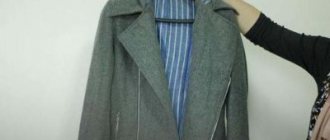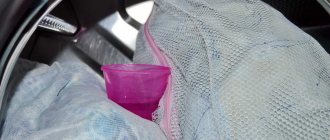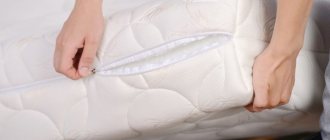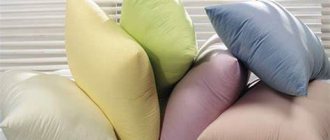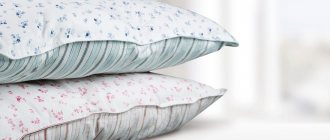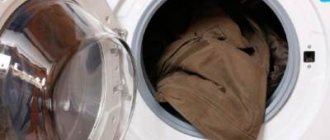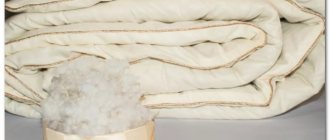It is not only possible, but also necessary to wash feather pillows, since over time the filler can accumulate a huge number of dust mites, which not only suck blood from those sleeping, but are also a strong allergen. It is possible to carry out the work on your own if you follow simple instructions and correctly organize all stages of the process.
Is it possible to do this?
The optimal frequency for washing bedding with down and feather filling is twice a year. If you do this more often, the filler will deteriorate and its quality will deteriorate.
Before you start washing, you need to understand what kind of feather the pillow is filled with - chicken or waterfowl (duck, swan, goose).
The necessary information is contained on the product label. The composition is indicated there and recommendations for caring for bedding are given.
Attention! If the filling is a chicken feather, you should not wash the pillow. These bedding items are dry cleaned.
A distinctive feature of chicken feathers is that they strongly select moisture and take a long time to dry. The filler in a dried pillow will disintegrate into small components.
Waterfowl in Peru are not harmed by moisture. Washing such pillows is not contraindicated; the main thing is to follow certain instructions.
To clean feather-stuffed bedding, use:
- machine washable;
- hand wash;
- steam treatment.
It is important to study and strictly follow all recommendations of the pillow manufacturer.
How to wash whole feather pillows
First of all, it is necessary to take into account that in many pillows the pillowcase is made of such dense fabric that it does not allow water to pass through well. Providing quality laundry is not easy. If the bedsheet is of medium density, you can try to do the work manually, following these instructions:
- It is necessary to pour water at a temperature of +30...+40°C, no more, into a bathtub or container of a suitable size.
- Only liquid washing powder should be added, as it is easier to wash out. Instead, you can use a little grated laundry soap, which is thoroughly dissolved in water.
- Place the pillow in the container and make sure that it is completely saturated with water; to do this, you can push it for several minutes so that as much liquid as possible gets inside.
- It is necessary to leave the pillow for several hours, then wrinkle it further and replace the water. This should be done 2 to 5 times, it all depends on the degree of contamination of the liquid.
- It is necessary to rinse the product in clean warm water. It should be changed until the foam disappears completely.
- It is best to dry in the sun, periodically turning the pillow over and fluffing it. The process may take several days. You should finish drying only when you are sure that the inside of the feather is completely dry; in this case, it is better to play it safe.
By the way! This option is best suited for small items; it is advisable to wash large pillows differently.
Preparing to wash at home
At the preparatory stage, the following manipulations are performed:
- Clean bedding from dust.
- Prepare bags for washing.
- Distribute the feather from the pillow into the bags.
- Knock out the pillow and place the fluff in the covers
- Dust that has accumulated during the period of use of the bedding is removed with a cracker designed for cleaning carpets.
- There is no point in using a vacuum cleaner; it is too powerful and can damage the upholstery. Reducing power will not give the desired effect.
- At the next stage, you need to sew special bags in which the filler will be placed. Washing the pillow completely is not practical.
- A dense layer of padding will not allow for quality cleaning. The fluff will turn into poorly dried, caked clumps.
It is recommended to sew 4 bags, using thick cotton fabric measuring approximately 25-30 cm. The length should be identical to the width.
Reviews from people who have washed feather pillows suggest that teak is the best option. It holds nimble fluffs and prevents small feathers from flying out of the cover during the washing process. It is not advisable to use gauze, even if it is multi-layered.
Advice! Instead of several small bags, you can use one large one, twice the length of the bedspread. If the pillow has standard dimensions, the length of the cover will be 140 cm.
The most important task is to distribute the stuffing among the bags:
- Close all doors and windows to avoid drafts.
- Lay out a sheet and place a pillow on it.
- Carefully press the napkin along the seam.
- Fill the bags with feather and sew them up carefully.
Before placing the filler in the bags, spray them with water. This will prevent the fluff from flying away.
If the condition of the pillowcase is satisfactory, shake it off, wash it and can use it again. If desired, make a new cover.
Old pillowcases can serve as laundry bags. But the fabric must be intact and dense enough.
Do you wash feather pillows by hand or in the washing machine?
By handIn the machine
Choosing funds
Washing is preceded by the choice of products.
Here it is important to remember the properties of fluff. Its structure is made up of thousands of threads that easily intertwine with each other and form a continuous tangle. It perfectly traps solid particles, so you can’t use granular washing powder. You won’t be able to get rid of small grains in the upholstery even with 3-4 rinses. This is fraught with an allergic reaction and hives.
The most suitable are considered:
- Laundry detergents that have a liquid consistency.
- Food acids.
- Oily hair shampoos.
Advice! When washing down and feather pillows in a machine, it is recommended to use balms or capsules. There are no problems with washing them out, and the structure and quality of the upholstery are not damaged.
From food acids, a bite or lemon is suitable. They do a good job of cleaning down-filled pillows. With their help it is easy to remove grease stains and dirt. But do not forget that vinegar leaves behind a long-lasting odor. Citric acid is more effective, but before use it must be dissolved in hot water.
If the listed products are not at hand, use regular shampoo. Bedding is subject to the same contaminants as hair. In this case, shampoo is as effective as balm.
Should I steam the seams or not?
- Washing should begin with steaming the seams.
- The filler is soaked in a basin or in the bathtub, and the pillowcase in the machine.
- After washing and drying the fabric, it is sewn and stuffed again.
This option is suitable for those who need not only to clean a pillow filled with feather or down, but also to restore it. After washing, the bedding will look like new.
It is not recommended to wash the entire pillow. This option is chosen by the lazy, but it has not worked well.
Important! The main thing is not to try to clean the down from dirt in the machine, placing it there separately from the pillowcase.
Even special bags will not prevent it from scattering throughout the drum. This method of washing is fraught with clogging of the filter and the nozzle that supplies water.
Machine washable
How to wash a feather pillow in a washing machine, all the rules:
- Wash only with cold water. Hot temperatures deteriorate the pen, and dirt is absorbed even more. Due to the incorrect washing mode, the pillow will smell unpleasant. 30 degrees is the limit.
- If there is a wash cycle for duvets or swan's down, select it.
- Avoid intensive washing, give preference to delicate washing.
- The same applies to spinning: either turn off the function altogether, or set the minimum speed. If you spin the pen in the drum at full power, it will come out of the case and break.
- Spinning at maximum speed also causes the pen to fall off. If you wash in the original cover, you will have to try to straighten out dense and uneven lumps.
- But it is better to repeat the rinsing twice or thrice. Feathers must be completely rinsed of powder to avoid allergic reactions.
- And to achieve the best result, wash the feather covers one at a time (2-3 pieces each).
- If there are few feathers and the drum is large, then add a couple of towels so that the load is even and the wash is of high quality.
- After washing without spinning, carefully press the bags to remove as much moisture as possible, and then remove the feather and send it to dry.
How to wash in an automatic washing machine?
To wash a pillow in the machine, you first need to place it there (if you decide to wash the entire bedding). It usually fits into conventional equipment with a 6-kilogram drum without difficulty. Washing in a mini-machine can cause the pillowcase to shrink.
Selecting mode and temperature
Washing is carried out at a temperature of no more than 40 degrees.
If there is a goal to preserve the original appearance of the bedding, you should not neglect this condition. Unlike synthetics, down and feathers are made of protein, resembling keratin. High temperature causes proteins to coagulate. Hot washing is fraught with loss of elasticity, the pillow will turn into a feather ball.
A cotton or linen pillowcase will also shrink from too much hot water. The napkin may decrease in size by a third. It is uncomfortable to sleep on a hard, shapeless pillow.
Which spin should I use?
Is it permissible to wash a feather pillow in a machine with a spin function - a difficult question. There are several points to take into account:
- Push-up intensity.
- Using squeezing balls.
Spinning can damage the fluff, regardless of the speed. You can set 1000 revolutions at once - this will speed up the drying of the pillow. It is unacceptable to use squeezing balls. They can damage the drum of the machine; they are of no use.
Without spinning, bedding will take a long time to dry, which is not for everyone.
In addition, the down may develop an unpleasant odor due to the moisture inside. If you decide to use the spin cycle, immediately after spinning the pillow must be placed on hangers, secured with clothespins. And after drying, beat it.
Drying the pillow correctly
The washed filling is laid out on a horizontal surface covered with cotton cloth. The fluff should lie in a thin, even layer. Detected tangles are sorted out by hand, and those that stick together even after washing are thrown away. The volume of the pillow may decrease, but it will become cleaner and without bumps.
Wet fluff is covered with gauze, otherwise it will fly apart. Drying takes place under natural conditions within 1-2 days.
IMPORTANT : our experts do not recommend washing pillows made from chicken feathers or down. Unlike duck and goose filler, the filler does not tolerate wet treatment, and subsequently quickly rots. Unpleasant odor, loss of volume, bacteria are the result of improper care. Take these items to the dry cleaner.
On open air
Ideal drying option. Try to protect the washed filling from rain, dew, and also protect it from the wind with firmly secured gauze.
Battery
This drying method cannot be used. High temperatures increase the fragility of down. The pillow will last much less.
Using special devices
Do not use a hair dryer or a fan with warm air. Let the fluff dry naturally. Stir it from time to time. This should be done directly under the gauze so that it does not fly apart. Yes, it is difficult, long, troublesome. But, what can you do, there is no other option - except dry cleaning, of course.
Video: how to wash and dry a feather pillow
Watch the video to know how to properly wash a pillow at home.
How to wash by hand?
Many people associate washing by hand with hard work. But in reality there is nothing complicated about it. The algorithm of actions should be as follows:
- Fill the bath with water whose temperature is about 30 degrees. It should be enough to keep the fluff on the surface.
- Dissolve the cleaning product, add laundry soap, do not use bleach.
- Pour feathers and down into the bath; there is no need to use laundry bags.
- Wait 2 hours.
- Gently clean the soaked filler by squeezing it with your palms.
- Collect the feathers in a colander and rinse under the tap or rinse in a basin filled with clean water.
- Squeeze with your hands and transfer to dry material.
During the rinsing process, you can drop a little essential oil or a tablespoon of vinegar into the water. This will get rid of the musty smell.
There is a faster hand washing method:
- Dissolve the cleaning agent in water whose temperature is less than 30 degrees.
- Open the pillowcase and pour its contents into three old pillowcases and sew them up.
- Place in the solution and, pressing with your hands, walk over the entire surface of the improvised bedding.
- Rinse at least 3 times.
- Wring out and hang the bedclothes to dry on a clothesline, shaking occasionally.
Important! The use of this technique reduces the quality of product cleaning.
To ensure that the feathers dry well, fluff up and do not get matted, wash your bedding in the warm season.
Handwash
Don't save time if you decide to wash your feather pillow by hand. This method is more difficult than using a typewriter, but safer for the pen itself.
All stages of hand washing:
- It is not necessary to distribute the feathers among the covers. They can be removed and washed in small portions.
- You will need a spacious basin and lukewarm water - 30 degrees.
- Dissolve the detergent in water with your hands.
- We take out the feathers and pour them into the water. We leave it there for a couple of hours.
- There is no need to subject the feathers to aggressive rubbing; soaking and a little stirring in the solution is quite enough.
- The main difficulty is rinsing by hand. Housewives came up with this method: take a large colander or sieve and remove the feather from the basin in portions. We wash all the feathers under a slow stream of cool water, squeeze them lightly and transfer them to a cloth to dry.
- Don't forget to put a protective screen on your bathroom drain to prevent a stray feather from clogging it.
Proper drying
One of the key steps in cleaning a pillow is drying it. At this stage, you cannot make mistakes; they will negate all your efforts.
The main rule is no rush. It takes approximately 3 days for the feather filling to dry completely.
Follow these simple guidelines:
- Place feathers and down on dry cloth or paper, stir while drying.
- Cover the top with gauze to prevent fluff from flying away.
- The filler can be dried next to the battery, but not on it.
- When drying feathers in bags, they are hung in the air, avoiding sunlight, beating them from time to time.
- You can use a hairdryer, but be sure to maintain a distance of at least 20 cm from the filler. The continuous exposure time should not exceed 10 minutes.
- Having finished drying, the feather and down are placed in a clean pillowcase and then sewn up. To ensure that the filler is evenly distributed, the bedding is shaken and lightly beaten with a clapper on both sides. To avoid contamination of the bedstead, it is placed in another cover.
Replacing napkins
Washing is a great reason to update your feather pillow covers. The cleaned and dried filler is poured into new prepared covers. The feather is compacted well: the product should be dense. It will settle a little during use.
For the bedstead, choose a special dense fabric - calico, satin, teak . It is first ironed with an iron.
Filling the covers with down is carried out on a pre-spread fabric to make the scattered down easier to collect.
If the old bedsteads are still suitable for use, they are washed. Heavily soiled covers are pre-soaked in water with washing powder. Stains are treated with laundry soap or bleach.
Place the napkins in the drum of the washing machine and turn on any delicate cycle. Afterwards, it is important to dry the cover thoroughly. It is ironed before filling.
Once the pillow is formed, the napkin is sewn up. They do it efficiently and carefully - feathers should not fly all over the bedroom. Place a clean pillowcase over the cover.
Traditional methods for cleaning pillows from dust and dirt
You can clean your feather pillow from dirt using traditional methods. They were used even before the advent of automatic machines.
Pre-soaking with lemon juice
Dry cleaning of bedding filled with fluff using lemon juice is unique. It has whitening properties and ensures effective removal of fats.
The original recipe uses natural lemon juice. You will need 6 fruits. You can replace them with simple citric acid. One lemon is equivalent to one teaspoon of powder.
To prepare bleach:
- Squeeze 6 lemons, remove seeds and pulp. Use a manual juicer.
- Heat 3 liters of water. We recommend taking distilled. Add the squeezed juice to it. For 0.5 liters of water you need 1 lemon.
- The pillow should be placed in a basin and filled with this substance. Water should completely cover the fabric.
- After 3 hours, wring out and wash the product.
Dry cleaning with baking soda and tea tree essential oil
To clean a down-filled pillow, you can use baking soda and tea tree essential oil. We are talking about a natural antifungal and bactericidal agent.
Together with soda, it forms a substance reminiscent of ordinary soap, but more effective.
Dry cleaning is performed as follows:
- In a container, mix 100 grams of regular baking soda and 12 drops of oil (can be bought at the pharmacy). You should end up with a slightly moistened powder.
- Bedding should be thoroughly rubbed with this mixture and left for 60 minutes. Then be sure to shake out and vacuum.
Steam cleaning
To add freshness to the filling and pillowcase and to destroy unwanted inhabitants, the pillow is exposed to hot steam.
To do this, use a steam generator or steamer.
You can use an iron instead if it has a vertical steam option.
At the dry cleaners
You can tidy up a pillow stuffed with feathers and down not only at home, but also at a dry cleaner. Industrial steam generators will allow you to achieve perfect cleaning.
At home
The cleansing procedure is extremely simple:
- The pillow is thoroughly steamed on both sides.
- Leave the bedding for a quarter of an hour, after which the procedure is repeated.
- Then the pillow is removed and shaken several times.
- Leave it in a horizontal position to dry. During drying, turn and beat several times.
Important! Steam treatment cannot replace a full wash. But it is capable of destroying pathogenic microflora and mustiness in 20 minutes.
Do you steam your feather pillows?
Not really
Care Tips
To extend the shelf life of feather pillows, take proper care of them:
- Wash or steam after you have had a cold.
- Use fresh pillowcases once a week.
- Ventilate your pillow in the fresh air once a month.
- Wash your pen thoroughly at least once a year.
- Use a steamer and vacuum cleaner.
- If the pillowcase is leaky, replace it.
- Whip the feather inside the case often to prevent it from caking.
Regular care of natural pillows at home will save the owner from unplanned expenses for dry cleaning. Take care of your bedding to ensure consistently excellent sleep quality.
Mistakes housewives make when washing pillows
When washing feather pillows, it is important to avoid mistakes. Let's list the most common ones:
- The more intense the foaming, the better the dirt will be washed away. This is an erroneous judgment. A large amount of foam will cause the feather and down to stick together. Use detergent as little as possible.
- One rinse is not enough. Pillows filled with natural down absorb detergents well and need to be rinsed at least three times.
- High temperature conditions negatively affect the quality of the filler.
- Use of air conditioners in large quantities. Don't overdo it, it's hard to get all the conditioner out of bedding.
Sleeping on a clean pillow will be sound, which means that the efforts made to clean it will be completely worth it. Don't be lazy to keep your bedding in good condition.
Find out how to properly wash bamboo and synthetic padding pillows. This article will tell you about washing an orthopedic pillow.
Selecting a detergent
Special products for cleaning products based on feather and down insulation are presented in a large assortment on the modern market of cleaning and detergents. Liquid detergents based on lanolin are best for washing feather pillow fillings. This innovative component will provide the most gentle and delicate washing of the pen, while perfectly preserving its structure. When washing, you should avoid cleaning products with a strong strong odor, as the filler will absorb this odor and create inconvenience when using the pillow in the future.
Important! To wash down feather pillows, it is advisable not to use granular detergents; microparticles of such detergents are very difficult to wash out of the feather structure.

